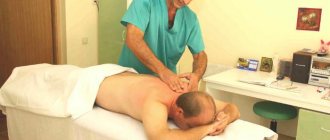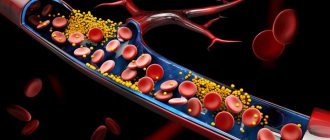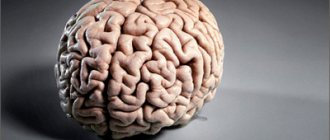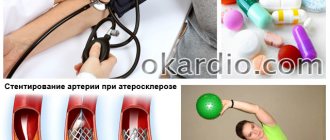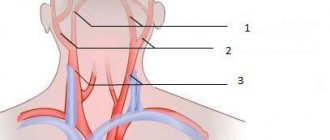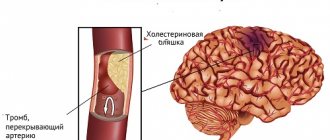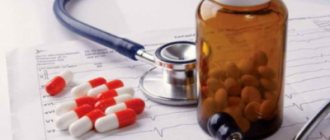Etiopathogenesis
The main mechanism for the development of paralysis is stroke - damage to the artery with blood escaping beyond the vascular bed. As a result, a hematoma is formed, which gradually grows and compresses the brain tissue. Vital neurons die, loss of function is noted, control of skeletal and smooth muscles decreases, and sensitivity disappears.
This condition is predisposed to:
- Eating disorders – the main role is played by a lack of calcium in the diet, which strengthens the walls of the arteries. In these cases, cardiologists repeat “where it’s thin, that’s where it breaks.” Weakened brain vessels that are prone to damage can cause a stroke;
- Hypertension – the situation is aggravated by increased blood pressure, which can damage weakened blood vessels. In older people, there is a lack of calcium, which can cause artery rupture;
- Compounded heredity - according to recent studies, there is a predisposition to vascular diseases, especially hypertension and strokes. The mechanism has not been fully studied; insufficiency of the neurohumoral mechanism and weakness of the vascular wall are assumed;
- Obesity - this condition is accompanied by a lack of minerals, an increase in blood pressure, which increases the likelihood of developing a stroke with subsequent paralysis;
- Cardiovascular diseases - valve malformations, heart failure, atherosclerosis and thrombosis predispose to cerebral hemorrhage;
- Endocrine diseases - diabetes comes first, leading to hypertension and hemorrhages. Sometimes the causes are hypothyroidism, pathologies of the adrenal cortex;
- Bad habits - nicotine weakens the walls of arteries and increases cholesterol levels in the blood. Natural alcohol in minimal dosages is useful, but an excess of surrogate or drunkenness often ends in stroke and paralysis.
The listed factors can provoke both left and right paralysis. According to statistics, the latter option is observed more often, which increases the patient’s chances of survival due to timely diagnosis.
Treatment options
- When treating paralysis, it is imperative to treat the underlying disease. For this reason, it is difficult to say unequivocally what exactly you need to do to improve your well-being. For example, if a person is found to have an abscess, neoplasm or hemorrhage, in most cases surgical intervention is required. When it is necessary to normalize blood pressure, a person is prescribed nootropic drugs , as well as angioprotectors . These products can improve blood flow and normalize a person’s well-being.
- If there are infectious lesions of the brain, the person will be prescribed antibiotics. It will be important to get rid of pathogens so that you can improve your well-being. When botulism therapy is required, a person is prescribed anti-botulism serum. If myasthenia gravis is diagnosed, then it will be important to improve neuromuscular conduction.
- In addition, the doctor will prescribe vitamins , as well as medications that are necessary to restore nervous tissue. A person also needs physiotherapy to help develop muscles.
- If treatment is started in a timely manner, then the body can be restored. At the same time, it will be important to strictly follow the doctor’s recommendations if you want to normalize your well-being. Additionally, a person is recommended to adhere to preventive measures, because with their help it will be possible to recover much faster.
- In particular, you will need to lead a healthy and active lifestyle, stop smoking and drinking alcohol. In addition, you will need to follow a certain regime: eat properly and in a timely manner, drink at least 1.5 liters of water , and also get good sleep.
- You will definitely need to consult a doctor in a timely manner if alarming symptoms occur. It is important to promptly treat diseases that are inflammatory and infectious in nature. It is imperative to monitor blood pressure, because it leads to negative consequences, including paralysis.
- A person who is faced with pathology is advised to move more. If this is too difficult a task for the patient, then he will need outside help. It is also necessary to perform breathing exercises that will engage the lungs. As you know, this organ does not work to its full potential during paralysis.
During treatment, you must be observed by a doctor so that you can monitor the progress of treatment. Your treatment regimen may need to be adjusted to help it work better. Under no circumstances should you start the disease unless you want to face irreversible consequences. These include muscle hardening and joint ankylosis.
Types of paralysis
After a stroke, the doctor’s main task is to determine the presence of paralysis and its type. All hemorrhages on the right and left sides are divided into two categories:
- Peripheral paralysis is the most favorable variant of the disease, characterized by partial loss of function. The patient's motor neurons are damaged, which leads to loss of sensitivity and a decrease in complex and purposeful movements.
- Central paralysis - indicates hemorrhage in the motor areas, as a result of which the right arm and leg are completely amputated. Such patients are unable to care for themselves and there is a high risk of disability.
General information
Paralysis is a pathological condition characterized by loss of the ability to move or impaired motor function in a certain part of the body or several parts. Paralysis is a symptom of a number of diseases of the nervous system. If the possibility of voluntary movements is not completely lost, then this condition is called paresis . This condition is not a separate disease, therefore, its occurrence is not provoked by a specific single factor. Motor function may be impaired due to a wide variety of damage to the nervous system. Thus, organic causes of paralysis can be a variety of injuries , infectious diseases , intoxication , metabolic disorders , vascular damage , nutritional disorders , malignant tumors , as well as hereditary or congenital factors. Quite often, paralysis is observed with syphilis , polio , viral encephalitis , tuberculosis , and meningitis . Toxic causes of paralysis may include beriberi (lack of vitamin B1 ), pellagra (lack of nicotinic acid), and poisoning of the body with heavy metals . Movement disorders often occur in congenital, hereditary, and degenerative diseases of the central nervous system. Thus, cerebral palsy often occurs as a consequence of birth trauma .
Impaired motor functions also occur in a number of diseases of unknown etiology. Paralysis also manifests itself as a consequence of psychogenic changes, in this case the help of a psychiatrist is effective. Due to such a wide range of reasons for which paralysis manifests itself, pathomorphological changes in this condition are very diverse in nature and localization. Thus, with paralysis , degeneration destruction , inflammatory processes , formation of lesions , sclerosis , and demyelination of nervous tissue . It is customary to distinguish between paralysis resulting from damage to the central nervous system and paralysis resulting from damage to the peripheral nerves. The first group of paralysis, accordingly, is divided into cerebral (their origin is subcortical , cortical , capsular , bulbar ) and spinal (causes are diseases that provoke a malfunction in the functioning of central and peripheral motor neurons). The causes of peripheral paralysis are lesions of the plexuses , nerve roots , nerves , and muscles .
Signs of right-sided paralysis
If there was a stroke in the left hemisphere, the patient’s right side of the body is affected, the muscles of the limbs are paralyzed and there is no speech. These are the main differences between this condition. Patients also develop the following symptoms:
- Common symptoms are headache, nausea, vomiting and weakness. They appear in the first few days and are considered the body’s response to damage to brain neurons;
- Loss of movement - with central paralysis, the right limbs are flaccid, there is no sensitivity, the patient cannot perform any actions with the right arm and leg. If peripheral neurons are affected, the patient experiences tremor, and some movements are difficult on the same side;
- Reduced memory – there are difficulties in remembering sentences; in severe cases, it is difficult for a person to repeat individual words;
- Paresis of the right facial nerve - this branch innervates all facial muscles on its side. In the absence of control, the muscles relax, the patient’s corner of the mouth and lower eyelid “hang”;
- Spontaneous contractions of some skeletal muscles on the right - usually the arm is bent at the elbow joint, the leg is straightened, and inward rotation of the foot is noted.
The listed symptoms are observed a few minutes after hemorrhage. As health deteriorates, the patient develops stress, accompanied by depression and difficulties in communication.
Consequences of right-sided paralysis
In severe cases, right-sided lesions lead to irreversible complications that develop as a result of massive hemorrhage or violation of treatment rules. We list the most common conditions:
- paralysis of both arms and legs;
- lifelong speech dysfunction;
- disturbance of thinking, memorization, social behavior;
- the appearance of bedsores;
- exacerbation of chronic diseases against the background of reduced physical activity;
- enuresis and fecal continence disorders.
The main task of the doctor is to create conditions that ensure full recovery after a stroke on the right side, which will minimize the development of complications.
Drug therapy
If the right side is paralyzed due to a stroke, you should start with drug therapy. The drugs of choice are:
- Antiplatelet agents and anticoagulants (Curantil, Warfarin) - thin the blood and improve its passage through the arteries. The use of these drugs is effective for atherosclerosis, thrombosis or vascular spasms;
- Diuretics (Hypothiazide, Veroshpiron) – remove excess fluid, prevent cerebral edema and hypertensive crisis;
- Antispasmodics (Papaverine, Vincamine) - relax blood vessels and improve blood circulation;
- Agnioprotectors (Parmidin, Alprostan) – have a beneficial effect on the arteries, preventing the development of spasms;
- Nootropics (Piracetam, Actovegin) - improve brain function. They are taken for a long time, including the rehabilitation period.
The doctor prescribes medications based on the patient’s condition. In severe cases, a complete list is written out, and daily blood pressure monitoring is carried out.
Diagnostic methods
Having examined the causes of paralysis, a person will come to the conclusion that he should definitely consult a doctor to understand what exactly is happening to the body. The specialist must find out what symptoms are troubling the person. In addition, a neurological examination is carried out, and the person is also sent for a blood test. It should be taken in order to determine the presence of inflammatory processes, as well as the fact of poisoning.
In addition, the person is sent for a computed tomography scan of the spinal cord and brain. It will be possible to understand whether there are any deviations in this regard. A person also needs to do electroneuromyography to evaluate the electrical activity of the muscles. In addition, the doctor may prescribe electroencephalography, which records the activity of individual areas of the brain. Magnetic resonance angiography is performed with a purpose. Assess the integrity and patency of the arteries.
Based on the test results, the doctor will prescribe treatment for paralysis. It is important for a person to strictly follow the recommendations so that there is an opportunity to improve their well-being.
Diet
Diet is necessary to improve blood circulation and maintain immune resistance. A well-chosen table should contain everything necessary for the regeneration of damaged tissues, but not overload the weakened body.
The basic rules for the diet are as follows:
- exclusion of smoked and fatty foods;
- meat can only be eaten with the approval of a doctor, in small portions and pureed. The menu includes only lean varieties;
- enrich your diet with vegetables and fruits;
- exclude coffee, strong tea, soda and alcohol;
- food should be fractional, in small portions.
For seriously ill patients, the menu is prepared by a nutritionist, taking into account the state of the body and the necessary energy costs.
Massage
This method is aimed at preventing bedsores and is used from the first days of paralysis. The right side of the body is warmed up, after which blood circulation and tissue trophism are improved, and mobility in the joints is restored.
To eliminate the effects of paralysis, a standard warm-up includes:
- stroking - from the periphery, along the blood flow;
- rubbing – carried out more intensively, similar to the previous method;
- vibration movements – in the area of soft tissues;
- The procedure ends with stroking.
To prevent new bedsores from arising, it is recommended to massage daily, regularly change the patient’s position and rub the skin with alcohol (if there are no wounds).
The right side of the body goes numb: reasons
As mentioned earlier, there are a huge number of factors that can influence this state of the body. However, if a person is sure that the problem is not related to hypothermia or prolonged stay in one position, then in this case we can talk about quite serious pathologies of the body.
You should not be negligent about your health. It is necessary to take a closer look at why the right side of the body goes numb. The causes of this condition may be hidden in various pathologies.
Visit to a speech therapist
To restore speech, daily training is required, which will be supervised by a specialist. The patient is given homework, including systematic exercises.
The objectives of such therapy are:
- restoration of oral speech;
- rehabilitation of writing;
- normalization of speech memory.
It is very important that a person not only learns to speak, but also understands the speech of others. Experts recommend that patients not isolate themselves, but constantly contact people.
